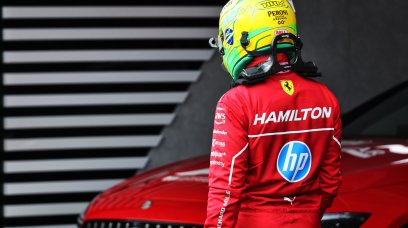During the opening lap of the Sakhir Grand Prix, everyone was holding their breath as Romain Grosjean's Haas burst into flames after perforating the guardrail, splitting the car in two. It was the type of crash not seen in F1 for decades. Immediately after the race an investigation was opened by the FIA. The findings from that investigation will be released in March by the FIA. RacingNews365.com understands that some crucial discoveries were made during the investigation. For example, the fire is said to have been caused by the hatch on the fuel cell, which stores the fuel, coming loose during the brutal impact. The picture below shows such a fuel cell, which complies with the FIA standard FT5-1999, as described in article 6.1.1 of the technical Formula 1 regulations. On both sides of the fuel cell there is, as can be seen in the picture, a hole, on which is a hatch that is screwed very tightly making it impossible for it to come loose. Yet during Grosjean's crash, the hatch in question came loose, allowing fuel to escape and in turn causing the blaze around the car.
The photo below of the wreckage, taken shortly after the crash, clearly shows that there is a hole in Grosjean's chassis where the hatch should be. The slider takes you to a photo from 2019, when the bodywork of Lance Stroll's Racing Point car came off and you can clearly see what the closure should have looked like, roughly. There you can see that it was secured with about 12 large screws.
This raises the question- how did the hatch come off? After the investigation, the F1 teams would have been asked by the FIA to take a closer look at the closure and whether it still corresponds to the requirements set by the FIA. RacingNews365.com asked all teams for a response, after which only Haas came up with an official statement. The statement read: "Haas F1 Team has always adhered to the FIA standards with regards to its car design and build, and in particular safety measures. We are always in full compliance of the regulations and, like all competing teams, we welcome initiatives and improvements to standards issued by the FIA and we implement them accordingly." RacingNews365.com understands that the design of the closure of the fuel cell of Haas F1 is similar to that of Ferrari, but the Italian team did not provide any further comment. There were other findings also made during the investigation. For example, Grosjean's headrest came loose during the accident. This too should not have happened. As it came loose, the approximate position in which the Frenchman found himself reportedly only became more oppressive and he had an even harder time escaping the wreckage and the ensuing inferno. As a result, the FIA has asked all Formula 1 teams to take a close look at their headrests and if they meet the suggested safety requirements. Ahead of the new season, an additional test for the headrest is now mandatory. A source within an F1 team told RacingNews365.com on condition of anonymity that they indeed had to make some adjustments to the headrest for 2020. "We have had to make small changes [to the headrest surrounding], but [ours] was nearly at the required standard - and we believe everybody will have had to make changes," the source stated. Another source from within a different F1 team revealed that the 2020 headrest was indeed slightly modified for the new test it is set to undergo ahead of the new season. "The 2020 one had to undergo some very minor modifications for the new test," they said. "So it's not a 100 percent carry over, but it took only minor changes to be okay." Finally, the pedal box at the feet of the then Haas driver also come loose, the investigation revealed, making it difficult for him to get his feet loose after the crash. In an interview after that terrible day, Grosjean already said that he, “Realized at one point that his foot was stuck.” Eventually he managed to wriggle free, but lost his shoe in the process. It is expected that the FIA will also come up with recommendations for changes in this area, which the teams will probably have to implement as of 2022. In all likelihood, the FIA will make its findings from the investigation public soon enough. In early March, the World Motor Sport Council will meet and the results will be discussed in detail. Undoubtedly, the report will also address, for example, the safety of the crash barriers in motorsport and there will be other recommendations made by the global motorsport federation in addition to technical ones.
Most read






